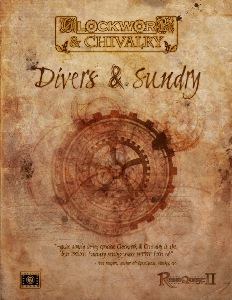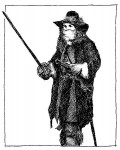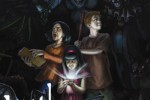Clockwork & Chivalry: Divers & Sundry
Clockwork & Chivalry: Divers & Sundry is a sourcebook for the RuneQuest II setting Clockwork & Chivalry designed by Cakebread and Walton (with material from Colin Chapman) and published by Cubicle 7 Entertainment.
By Peter Cakebread and Ken Walton

Welcome to the fourth Designer’s Diary, a regular column where designers are given the opportunity to take readers on an in-depth ride through the design and development process of their system, setting, or product.
Designer’s Description
Divers & Sundry is a 180 page companion sourcebook for players and gamesmasters of the Clockwork & Chivalry RPG. Whether a veteran campaigner or new to the weird and wonderful world of 17th century clockwork and alchemical warfare, there’s something in here for you.
There are lots of new Professions and Factions; there are two extensive sections on the weapons and soldiers of the age; there is an in-depth section exploring Scotland as a place for adventure in the Clockwork & Chivalry universe; tables and charts aplenty, including random NPC, Village and Adventure Seed generators – in fact enough tables to generate almost anything you need to populate the setting; three complete adventures; and a host of pre-generated characters for your players. The book collects articles from Signs & Portents, which have been expanded and fully illustrated, alongside a host of new material, and the Witchcraft rules from Thou Shalt not Suffer for those wanting to play Witches, Wise Women or Cunning Men.
Purpose
We want to provide a solid companion to the Worldbook, adding in options for Game Masters and players of Clockwork & Chivalry. We wanted to create a collection of useful and interesting stuff for C&C . We decided that it should be a large book, covering a host of topics, but with certain themes – martial options; random tables; and adventures, etc. Although we have tended to add extra setting material in the adventures we have released so far, for the Kingdom & Commonwealth Campaign, and will probably continue to do so, everything you need to play is in the Worldbook (and MRQII). What are available in Divers & Sundry are lots of cool add-ons, with which to enhance your game, as well as a whole extra country (Scotland) to be used as a setting. As ever, we concentrate on producing a book we would enjoy, find useful and want to buy ourselves.
Influences
By this stage (D&S will be the 6th Clockwork & Chivalry book) we have probably become quite self referential. The initial idea for the setting came from a small piece of original fiction by Ken. He wondered whether it was worth resurrecting and re-working and a fevered collaboration session, involving cider and wild speculation took place. The components and personalities changed, as the transformation into a RPG took place, but the idea of Clockwork and Alchemy in the Civil War started there. The style of the adventures throughout the series is undoubtedly influenced by the adventures we love ourselves – the classic Enemy Within Campaign for WFRP, Cthulhu campaigns, etc., although never intentionally so – we have tried to hit our own style, but nothing occurs in a vacuum.
Research
Research is usually a lengthy part of the process for any Clockwork & Chivalry release. We feel that’s the least we can do – if someone is buying our product they should expect a high level of detail and the tools to build a richly atmospheric gaming experience. We have our own extensive library of history books, and in addition use a host of online resources. We ground ourselves in what we are going to write about before we start and cross reference material for accuracy. Much of the information is out there, but some of the more specialist areas involve more in-depth research. For instance, in the case of the section on Scotland we read books focused on Scotland’s history and Peter visits the place regularly. Having already produced five books for the setting this becomes a little easier, as we have a foundation on which to build, but the setting is full of complexities and contradictions and we like to expose these in an organised way for the reader.

Art Direction
We work extremely closely with our artists. The cover is usually the first piece of art to be completed. When we have done our initial planning for the book we give our cover artist, Gary Buckland, certain themes and a rough idea of what the book is about, and he comes back with his first draft. And it is invariably brilliant. Tim Rigby, who handles all of the interior drawings, meets with us a little later down the line. We usually meet with Tim every week or two, assigning art jobs for him to tackle for the next fortnight and receiving the last batch he has completed.
Having worked on all our previous books Tim knows the kind of style we are looking for, and we generally just discuss any particular period features we want to include. Tim works at a heroic pace, and without his skill and commitment we just couldn’t do what we do. Divers & Sundry has been put together a little differently, as it is part compilation (just under half is collected material, the rest is original) – so we have had a little more time than usual to put it together. Nevertheless, we soon realised that the book required more art than usual – poor Tim! It is longer than our previous adventures, and only a little shorter than the Worldbook, which was not fully illustrated by Tim. This is full of Tim’s work, and he has risen to the challenge magnificently.
Gaming Experience
We realise different groups have different styles of play. Some Gamesmasters like to run there own sandbox, and with a small adventure seed and a couple of strong NPCs build, with their players, their own great stories. Others like to have a fully prepared adventure which covers most bases for them. We’ve never believed one style to be better than the other, so have always written for both. If you want some ideas and a sandbox to play in, you’ve got it. If you want something with a strong storyline and the work done for you, you’ve got that too. What you are guaranteed is a setting which has a grim, vividly historical and, at times, darkly humorous feel.
Comparison
Showing our age, the book does a similar job for Clockwork & Chivalry as the Hogshead Publishing Apocrypha books did for Warhammer FRP. There are plenty of other examples of compendiums brought out for RPGs, but that is probably as good as any.
Development Process
This book is a different format to our previous work as it is a compendium, rather than one complete piece; and because we have a third writer on board, Colin Chapman, of Radioactive Ape Designs. But we still approached it in a similar (if more drawn out) way to our other books.
We start by meeting and exploring what we want to cover in the book. We storyboard and chapter plan (although the storyboarding for the adventures, for example, had already been done months ago in this case). This didn’t take so long as usual, as we had a pretty good idea of what we wanted to do in the compendium and didn’t have a longer storyline to develop (as opposed to, for instance, the Kingdom & Commonwealth books).
So we have a rough contents guide, including estimates of how many pages will be in each section. Then we divide up the work and start writing. We generally agree on who should take on what, pretty much knowing each other’s strengths. Generally Ken gets to do the Magick and science, Peter the history and characterisations (or, let’s face it, the “crazies”). Sometimes one of us will have the initial idea, but the other one will develop it. In this case, Colin took on work as well – volunteering to do the martial stuff – expanding greatly the material on weaponry and soldiering, as well as some other things he fancied turning his hand to. It has been brilliant collaborating with another designer, particularly one who produces so many great games of his own.
As the work gets done we meet with our artist, Tim, and give him our requests for illustrations. Generally we check each others’ work and do a first edit before sorting out the page-setting. At this point there is usually a flurry of emails and phonecalls as we tease out any improvements, things we wish to add or remove, etc. So although writing is fairly solitary, we co-work at every stage. In some cases we might suggest minor re-working – but in this case we have had a clear common idea from the start about what was going in, so that stage was not required. As the finished, “first edit” material and pictures come together Ken usually starts putting it together in the book format. Then we meet and do an extra stage of editing together. If we have big, new mechanics then we like to get them playtested. Then it is time for the final draft and sending the work to Cubicle 7 for publication.




